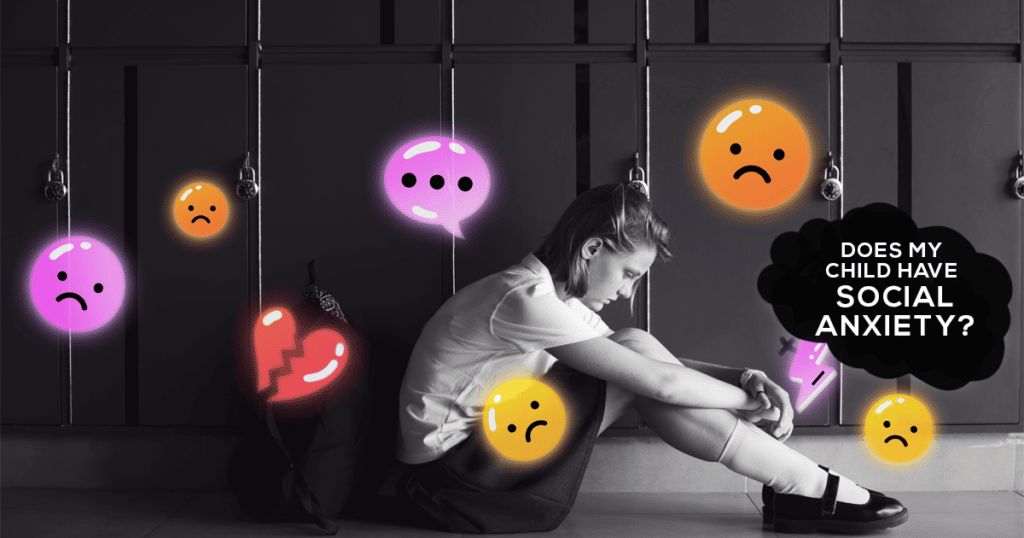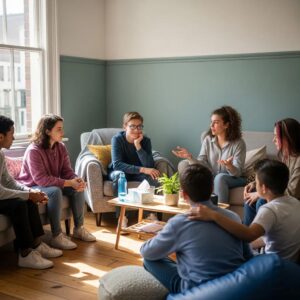Social anxiety disorder is something that goes beyond just being shy. This diagnosable mental health disorder and medical condition are characterized by a persistent, intense fear of others watching and judging you. There are impacts on daily life, including school, work, and other activities. Unmanaged social anxiety disorder can make it hard to form and maintain friendships, seriously affecting a person’s daily routine. The condition is treatable and often first begins to appear in childhood.
Social anxiety differs from panic disorder, generalized anxiety disorder, or other similar mental disorders, although they can occur together. When there are multiple mental health disorders diagnosed, it’s known as co-occurring disorders.
As a parent, if you’re asking yourself, does my child have social anxiety, the following are things to know and consider.
Understanding Social Anxiety Disorder
Social anxiety is a subtype of an anxiety disorder. Someone with social anxiety disorder symptoms will often feel fearful or anxious in situations where others might evaluate or scrutinize them or think they will. Even doing simple, everyday things such as eating or using the restroom in front of others can cause someone to feel that they’re going to be judged, humiliated, or rejected.
Many people with social anxiety disorder realize their fear is not logical or is out of proportion to the situation, but they can’t control it. It can get in the way of attending school or accomplishing everyday things. Someone with this disorder might worry about social interactions or situations weeks before they happen or avoid going places that make them feel distressed.
A child with a social anxiety disorder is so scared of being embarrassed they won’t do things they need to or want to, such as going to birthday parties or speaking in class.
Social Anxiety in Children
In kids, social anxiety usually begins between the ages of 8 and 15. At first, kids may be able to hide what they’re experiencing, and it can take some time for teachers or parents to notice an issue. Kids with the disorder fear eating in the cafeteria or answering a question in class because of their irrational fears.
The particular situations that will trigger anxiety will vary depending on the child. One child might want to ask a question in class, but they’re afraid they’ll look stupid. For another child, sitting with other kids at lunch might be what creates anxiety. When a child struggles with this type of anxiety disorder, they often think everyone can see how they feel. Some kids try to hide their feelings when their anxiety is high, and others lash out with anger or aggression.
Having social anxiety isn’t about social situations. Instead, it’s a fear of how people will perceive you.
Symptoms of anxiety related to social interactions in children include:
- Fear of situations where there’s a concern of being judged negatively
- Worries about humiliating or embarrassing yourself
- Intense anxiety or fear of talking to or interacting with strangers
- Worries about other people noticing your anxiety
- Being fearful of physical symptoms that can cause embarrassment like sweating, blushing, or trembling
- Avoiding doing certain things or speaking to people because of a fear of embarrassment
- Avoiding situations where you could be the center of attention
- Anxiety when anticipating an activity or event
- Worrying excessively about performance situations, such as speaking in front of an audience
- Intense fear or anxiety in social situations
- Analyzing how things went and identifying flaws in interactions after a social situation
- Expecting the worst consequences to come from a negative social experience
In younger children, these anxiety symptoms might include crying, clinging to parents, refusing to speak in social situations, or having tantrums.
Physical symptoms of social anxiety can be similar to panic attacks and may include:
- Trembling
- Blushing
- Rapid heartbeat
- Sweating
- Nausea or upset stomach
- Having a hard time catching your breath
- Feeling lightheaded or dizzy
- Feeling your mind goes blank
- Muscle tension
Situations someone with a social anxiety disorder might avoid include:
- Going to social events or parties
- Going to school
- Interacting with strangers
- Starting conversations
- Making eye contact
- Going into a room where people are already seated
- Returning things to a store
- Eating in front of other people
- Using a public restroom
The causes of social anxiety in children and adults usually come from a complex combination of biological and environmental factors. Anxiety disorders tend to run in families, and there’s also a structure in the brain, the amygdala, that can play a role in controlling the fear response. If someone has an overactive amygdala, their fear response may be heightened, leading to increased anxiety when they’re in social situations.
There are possible environmental influences that can be part of the disorder too. For example, some people may develop anxiety after a negative or embarrassing social situation, or there can be an association between the disorder and parents who show anxious behavior in social situations. Sometimes, social anxiety may be more likely if parents are overprotective of their children.
Overcoming Social Anxiety
Treatment options are available for adults and children with social anxiety symptoms. This includes options for anxiety treatment without medication.
In children, behavior therapy alone is the first-line option. Behavioral therapy and medication can also be used to treat anxiety disorders.
Cognitive behavioral therapy (CBT) is one of the primary approaches for social anxiety disorder that helps kids learn how to manage emotions and develop coping skills.
CBT is one of the leading treatments for anxiety disorders, and research shows it’s effective for treating social anxiety.
In CBT, the goal is to help identify irrational beliefs and thought patterns to replace them with realistic ones. Thoughts, emotions, and behaviors are all linked to one another. When someone learns to identify unhelpful thoughts, they can change feelings and behaviors.
As part of therapy, there might be work on understanding negative beliefs about abilities and self-worth. Other problem areas addressed during CBT social anxiety treatment include:
- Embarrassment, guilt, or anger over situations in the past
- Learning how to be more assertive
- Dealing with perfectionism and being more realistic
- Tackling procrastination that relates to social anxiety
- Overcoming mistaken beliefs that others are judging you
Exposure therapy is another way to treat this mental health condition and help alleviate feelings of anxiety in controlled environments first, improving quality of life. With exposure therapy, a child will work with a mental health care provider to gradually experience situations triggering their social fear.
It’s less common to use medication for treating social anxiety in children, but it can help kids who are very anxious or who aren’t comfortable participating in therapy. Most experts recommend that a child with mild to moderate anxiety be treated with CBT first, and then medication can be added if the therapy alone isn’t helping their symptoms.
A combination of medicines could be used if a child has severe anxiety.
Anxiety Treatment for Teens in Southern California
Please contact Hillside Horizon for Teens today at 855-746-8378 if you’d like to learn more about the anxiety treatment options available and how we can help your child overcome social anxiety. We’ll explore treatment options that could work for your family and help you learn more about working with a mental health professional.





